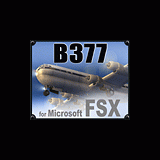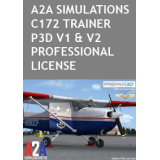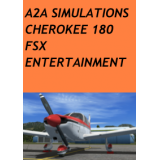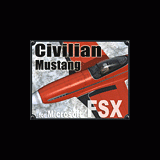History
Without a doubt, the Messerschmitt Bf 109 was Germany's most important, and most numerous, fighter of World War II. With more than 30,000 of all variants produced, it is easily the most numerous of any fighter type of the war. First flown in 1935 as the Bf 109a, this arch-enemy of Great Britain was fitted with, of all things, a Rolls-Royce engine. It did not meet with instantaneous enthusiasm from pilots used to open cockpits, two wings, and great low-speed agility such as the biplanes of World War I. However, it was ultimately ordered into production and in time, developed into the superior E-4, when the DB 601 engine was finally available in quantity.
The "Emil" was a fine aircraft and served well on the front lines through the middle of 1940, when its limitations became more obvious. The most glaring problem was range. In addition, while the top speed of the aircraft was identical to the Spitfire Mk I against which it was matched, it did not dive well and suffered from poor fuel economy due to its rather cobbled-together design. The underwing radiators added considerable drag, and the controls tended to feel as though they were embedded in cement after about 400 mph indicated airspeed. The Emil had a good deal of trouble pulling out of a fast dive, and more than one Bf 109E pilot was killed trying to follow a Spitfire in a dive. The elevator simply would not provide enough force at high speed to pull out if the pilot waited until he was too close to the ground.
Despite these shortcomings, the plane had strengths that could be exploited. The direct fuel injection meant the engine would never cut out due to negative g-forces, as would the Hurricanes with their gravity carburetors. The plane was quite agile at low and medium speeds and had well-harmonized controls up to about 300 mph indicated airspeed. The automatic leading edge slats did have their advantages in a tight turn, although the Spitfires, with their much greater wing area, could still turn inside the Bf 109 without any problem.
A well-flown Bf 109 E, regardless of its warts, was always a worthy competitor for a Spitfire Mk IA, and was a better plane than the Hurricane in many respects. However, in the end, the plane was not developed quickly enough and it was the Focke-Wulf 190 to which the torch was passed in the spring of 1941. By that time, the Battle of Britain was over and a different kind of war had begun, this time over the European mainland.
The Bf 109 was developed into several more refined variations, with the Bf 109G perhaps being the best overall of the bunch. But the Bf 109 E is the one that most World War II aficionados will recognize because of its prominent role in the Battle of Britain. It truly was one of the seminal fighters of World War II, and no collection of the best fighters of the early war would be complete without it.
General Information - Messerschmitt Bf 109 E-4
The Bf 109 E-4 appeared first in late 1939. Later versions, as depicted by the Wings of Power aircraft, utilized the DB 601Aa engine of 1175 HP for takeoff, and incorporated a single 20 mm cannon that fired through the propeller shaft as well as the usual complement of two cannon in the wings and twin 7.92 mm machine guns in the cowling. This was perhaps the most common of the German fighters to participate in the Battle of Britain, and several variations, including a fighter/bomber capable of carrying a 250 kg bomb, were evolved from this version.
- Empty Weight: 2,051 kg (4,522 lbs.)
- Wingspan: 36.5 feet
- Wing Area: 174 square feet
- Normal Takeoff Weight: 2,531 kg (5,580 lbs.)
- Maximum Takeoff Weight: 2,834 kg (6,250 lbs.)
- Top Speed @ sea level: 290 mph TAS
- Top Speed: 355 mph TAS @ 16,400 feet MSL
- Stalling Speed, clean (5,580 lbs.): 120 km/hr (65 knots) IAS
- Stalling Speed, landing (5,580 lbs.): 98 km/hr (53 knots) IAS
- Service Ceiling: 10,000 meters (32,810 feet)
- Powerplant: Daimler-Benz DB601Aa, 1175 HP Takeoff, 1100 HP for climbing.
- Armament: (2) 7.92 mm machine guns firing through the propeller with 500 rounds per gun, one 20mm cannon firing through the spinner with 200 rounds, and one 20 mm cannon in each wing with 60 rounds per gun.
Weights and Loading
The Wings of Power Messerschmitt Bf 109 E-4 is equipped with realistic payload, fuel, and station load positioning. This aircraft carried all of its fuel behind the pilot, to counterbalance the weight of the engine. With a full fuel load and ammunition payloads, the aircraft is well-balanced with a CG of 26.8 percent. With no fuel and all other payloads, the CG is reduced to 18.9 percent, which is a very nose-heavy condition. Removal of the ammunition payloads has little effect, changing the CG to 19 percent. When fully-fueled and loaded, the aircraft is rigged to take off with neutral trim, and if the ammunition weight is removed, a slight nose-down trim of up to 1 degree is desirable but not necessary. The fully-loaded and fueled plane is well-balanced and easy to fly, and even with a low fuel load, adequate trim is available to compensate. There is a 60-lb. weight placed behind the pilot strictly to compensate for the weight of the engine. This should remain in place at all times.
When on the ground the plane is quite tail-heavy and brakes can be use firmly with little danger of "nosing up" or tipping over and striking the propeller. However, this makes turns more difficult. Apply differential braking and power to assist with turning.
Cockpit Check - Controls
- Parking Brake - Set
- Fuel Selector - Main tank ON
- Elevator Trim - neutral
- Flaps - 20 degrees
- Propeller Control - 12:00 position
- Radiator flaps - OPEN
- Flight Instruments - Checked and Set
- Engine Instruments - Checked
- Switches - Checked
Mixture Control - Fuel Management
This aircraft is equipped with direct fuel injection and no mixture adjustments are possible.
Radiator Shutter Control
The radiator shutters increase drag and thus should be closed unless climbing or taxying. Top speed will be reduced if the radiator flap is open.
Propeller Control
This aircraft is equipped with a fully-feathering VDM airscrew and the control of engine RPM is somewhat different than on aircraft with a normal constant speed propeller, which limits blade angle. The Bf 109 E propeller can be placed in any position from 22.5 degrees (fine pitch/high speed) to 90 degrees (fully feathered). This gives the aircraft certain advantages which tend to help it but also requires additional attention from the pilot. At the fully-feathered position, which is also called the "dive" position, the prop creates very little wind resistance. In this position, with the prop control pulled all the way back, the plane will certainly dive faster. However, the throttle must be cracked at least slightly open during a dive because if it is pulled back to idle, the engine may quit after pulling out of the dive. The prop will create almost zero thrust and drag at the feathered position but it creates a considerable load on the engine and if it stops windmilling, as at the end of the dive, the engine may stop.
The much greater propeller range allows the RPM to be reduce to just above idle with considerable thrust. For cruising, this is called the "patrol" setting and allows RPM settings of as low as 1200, much lower than those seen on comparable Allied aircraft which have blade limitations. This feature compensates to some degree for the much higher coefficient of drag exhibited by the Bf 109 E airframe, which results in much higher fuel consumption during cruise and tends to limit diving speed. If the propeller is fully feathered during the dive, the Bf 109 E can be competitive with the Spitfire, but it still cannot dive quite as quickly and is much harder to pull out of the dive as the controls become much less responsive than the Spitfire at high indicated airspeeds. Likewise, the deeper angle achievable by the Bf 109 E propeller allows very low engine RPM with fairly high boost pressures and good thrust levels. Even so, the Bf 109 cannot match the Spitfire in specific range.
Engine Starting
- Cockpit Check - COMPLETE
- Hold brakes.
- Turn the battery switch ON.
- Recheck fuel supply ON.
- Turn the magneto switch on BOTH.
- Set fuel cutoff control to ON.
- Use manual fuel pump to pressurize the fuel lines.
- Prime engine if cold using priming pump (3-4 shots).
- Turn master ignition switch ON.
- Engage starter switch until the engine starts.
- Check engine instruments to confirm oil pressure rises to at least 4 kg/cm2 within 30 seconds.
- Fuel pressure should rise to 1-1.8 kg/cm2.
- Idle at 700 RPM until the oil temperature reaches 30 degrees C.
- Turn ON generator.
- Turn ON avionics.
- Check all instruments for proper function.
- After warm-up, idle at 800 RPM or slightly less.
Pre-takeoff and Taxi Check
- See that the elevator trim tab is properly set.
- Check prop is set to 11:30 on the pitch clock.
- Recheck fuel ON.
- Check flaps are at 20 degrees.
- Check radiator flap is OPEN.
- Test brakes.
- Check the magnetos at 1900 RPM. 150 RPM drop maximum.
Takeoff
The takeoff procedure for the Bf 109 E is somewhat different than for the Spitfire or other fighters of this type. The aircraft is very tail-heavy, which creates additional stability and eliminates the need for a tailwheel lock. However, instead of holding the stick full back, hold the stick fully forward and to the right, placing it in the right corner of the cockpit. The tail is slower to come up than on the Spitfire, but comes up easily enough once the plane gets up to about 100 kph IAS. Use the rudder for directional control as you would with any taildragger of this type. However, do NOT take off in a three-point attitude or try to hoist the plane off the ground too quickly. The leading edge slats may deploy automatically and create a control problem. Hold plane level on the main wheels and make sure you have plenty of flying speed, and then lift off gently. After retracting the gear and flaps, climb normally at the desired speed (see "Climb Control" below).
Normal takeoff power is 1.25 ata and 2400 RPM. Set the propeller clock at 11:30 for this RPM setting (approximate, adjust after takeoff). War emergency power of 1.3 ata and 2500 RPM can be used if desired. See engine limitations below for more information.
After Takeoff
- Raise the landing gear.
- Raise the flaps.
- Adjust the engine RPM to 2400 RPM.
- Trim the aircraft as required for climbing.
- Leave radiator flap open.
- Check all instruments.
Climb Control
A standard climb per the manual is made at 250 kph IAS (135 KIAS) at sea level with a manifold pressure of 1.25 ata and the engine set to 2400 RPM. A climb to 6000 meters (19,700) feet can be accomplished in about 7.8 minutes and will cover about 21 statute miles. As you climb, allow the indicated airspeed to decline until you are climbing at 112 KIAS at 6000 meters (19,750 feet) and 105 KIAS at 8,000 meters (26,300 feet). A climb to this altitude will use about 17 gallons of fuel. For maximum performance, climb at 1.3 and 2500 RPM (5 minute limitation). This climb will allow you to attain the greatest height in the shortest distance.
The climb can also be made at higher speed, beginning at 275 kph IAS (148 KIAS) at sea level. Maintain this climbing speed until reaching 6,000 meters, and then allow the speed to drop to 225 kph IAS (122 KIAS) at 8,000 meters. The rate of climb is slightly faster, and the distance covered will be substantially farther. The engine will stay much cooler at the higher indicated airspeed.
For maximum range, climb at 1.0 ata and 2100 RPM with a steady climbing speed of 265 kph IAS (143 KIAS).
Cruise Control Schedule
Calculate your fuel consumption and time to your destination using the following table.
| Altitude, feet (m) |
km/hr IAS |
Manifold
Pressure |
RPM |
km/hr TAS |
GPH |
Specific
Range, NM/gal |
| 3280 (1000) |
275 |
0.7 ata |
1200 |
315 |
30 |
5.8 mpg |
| 16,400 (5000) |
270 |
0.7 ata |
1300 |
340 |
32 |
5.8 mpg |
| 23,000 (7000) |
235 |
0.6 ata |
1500 |
335 |
29 |
6.3 mpg |
| 19,700 (6000) |
445 |
1.15 ata |
2200 |
515 |
81 |
5.0 mpg |
Engine Limitations and Characteristics
The Daimler-Benz DB601Aa engine is an excellent performer to medium altitudes. This engine had an improved supercharger coupling and was able to reach slightly higher top speeds, at slightly higher altitudes, than earlier versions of the Bf 109 E-4. War Emergency power should be used for only five minutes at a time.
| ENGINE POWER CHART |
TAKEOFF
MAXIMUM |
TAKEOFF
NORMAL |
WAR
EMERGENCY |
MILITARY
POWER |
MAXIMUM
CONTINUOUS |
MAXIMUM
CRUISE |
ECONOMY
CRUISE |
| Boost |
1.3 ata |
1.25 ata |
1.3 ata |
1.25 ata |
1.15 ata |
1.15 ata |
0.7 ata |
| RPM |
2500 |
2400 |
2400 |
2400 |
2200 |
2200 |
1200 |
Landing (5,500 lbs)
- Check fuel ON.
- Set the prop to about 2400 RPM (11:30 on the pitch clock).
- Check the traffic pattern and obtain clearance to land.
- Slow down to below 350 kph IAS and lower the landing gear. Retrim as needed.
- Lower the flaps to about 20 degrees after slowing to 250 kph IAS. The flaps are manual and will take some time to lower.
- The normal speed in the traffic pattern with wheels down is 200 kph IAS.
- Lower the flaps to the second position after turning to your final approach.
- Fly the final approach at 150 kph IAS , crossing the runway threshold at 145 kph IAS.
- Break your glide just above the runway and touch down with the tailwheel a little off the ground at 125 kph IAS.
- Lower the tailwheel gently.
- Brake as necessary. The brakes can be used more aggressively due to the aft center of gravity.
Flight Characteristics
The Bf109 is a very pilot-friendly aircraft and has no real vices. The narrow undercarriage requires extra attention during taxi maneuvers and the heavy tail requires differential braking and application of throttle to turn easily. Roll response is quite good up to about 450 kph IAS (300 KIAS). Beyond 640 kph IAS (350 KIAS), however, the controls will get very heavy and the aircraft will become very difficult to roll. Do not exceed 750 kph IAS (405 KIAS) in a dive. The elevator loses authority quite quickly at higher airspeeds, making the plane more difficult to get into an accelerated stall (the automatic slats also help with this), but in a dive the lack of elevator control can be problematic. Be sure to pull out while you have plenty of altitude, above 1000 meters (3,280 feet) AGL.
Stalls
A power-off, 1g stall is very gentle for this type of aircraft, owing in part to the automatic slats. The wing will drop to one side or another, usually to the left if there is any power applied. Recovery is normal. Accelerated stalls will result in a more sudden departure and will require immediate corrective action but there is usually plenty of time to recover. The aircraft will spin if not brought back under control promptly, but spin recovery is usually prompt, within one turn, with normal recovery procedures.
Spins
Like any high performance plane of this type, spins are not recommended. The aircraft will tend to lose a good deal of altitude if recovery is not immediate. Power-on spins are much worse; if the aircraft spins with power on, cut the power, push the stick forward, neutralize the ailerons, and apply rudder opposite the direction of the spin.





